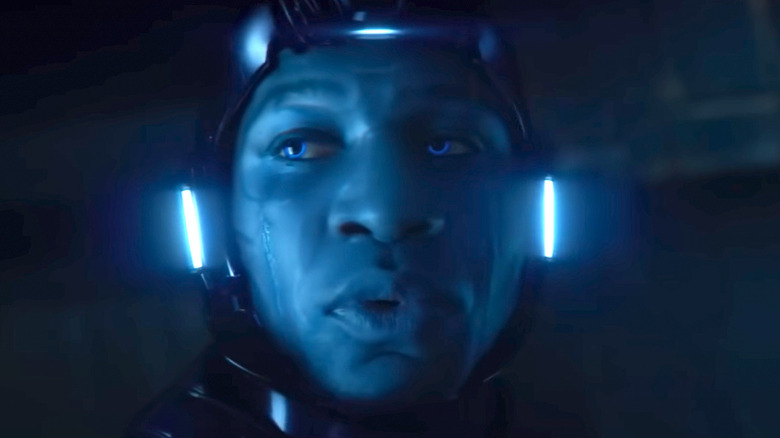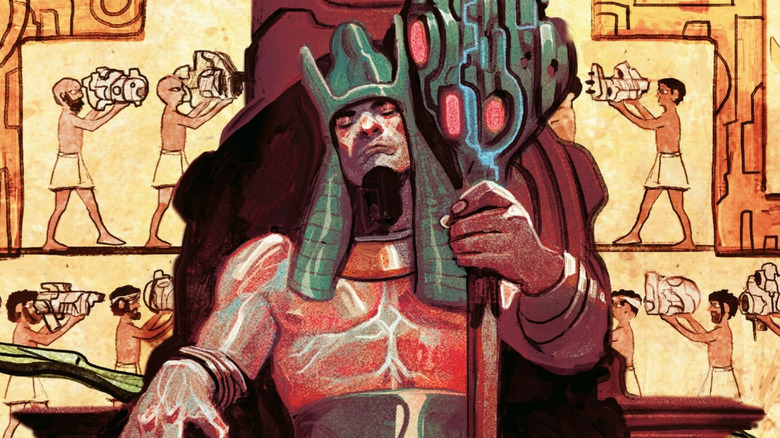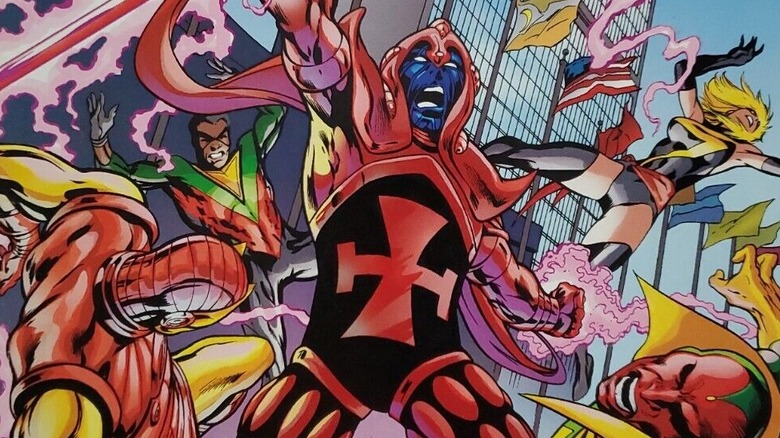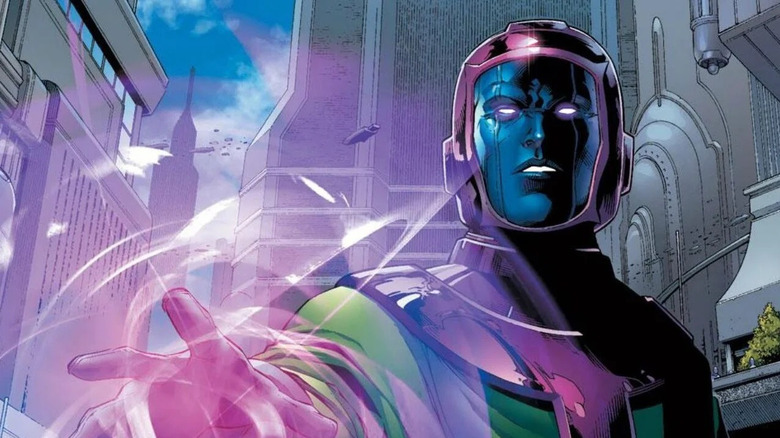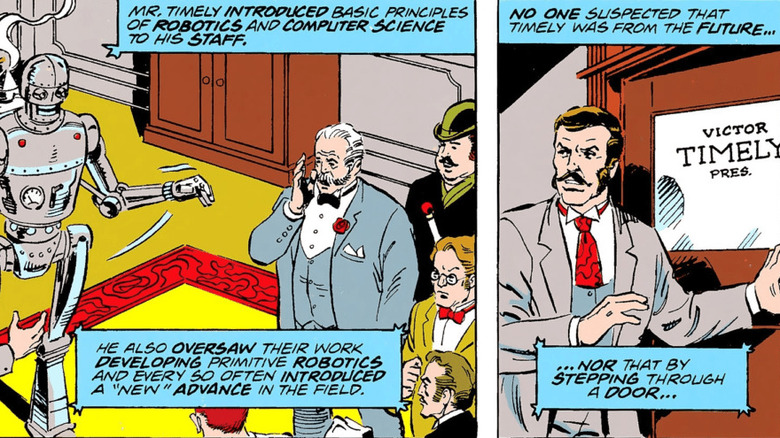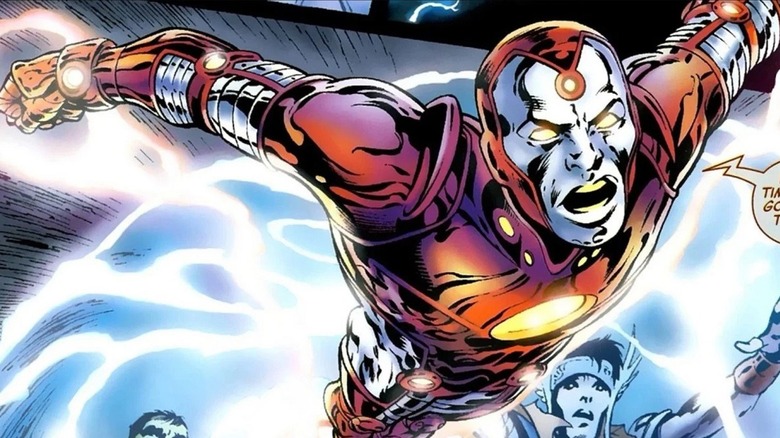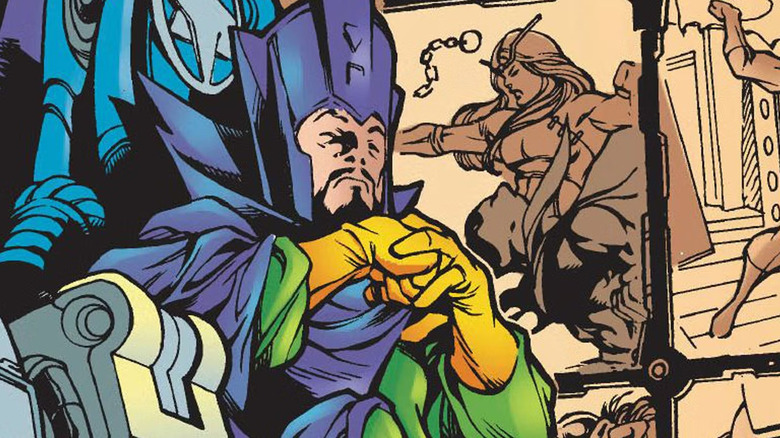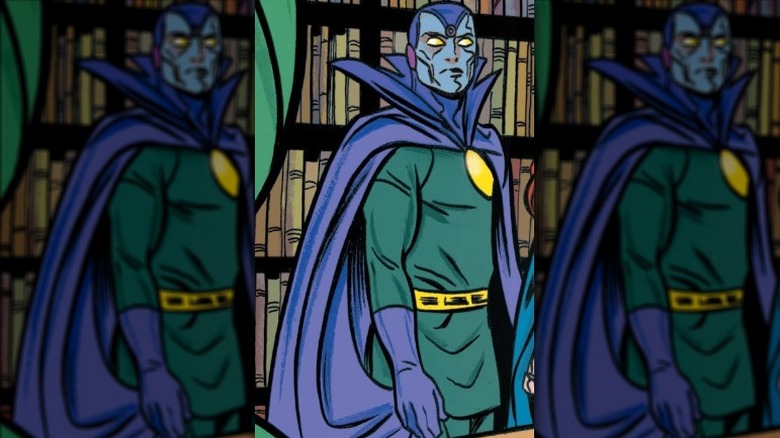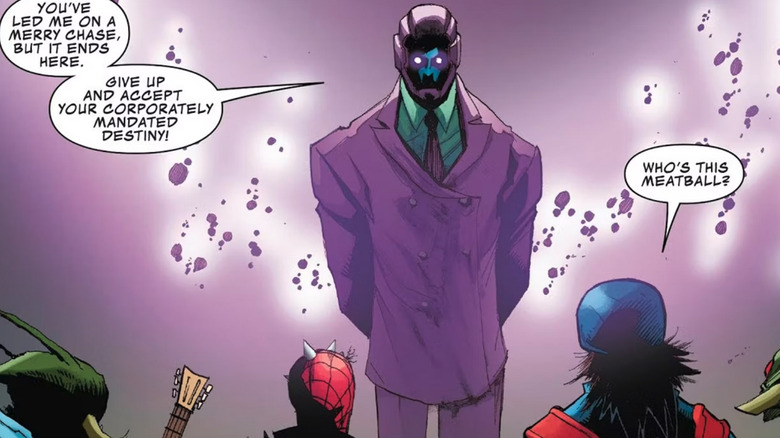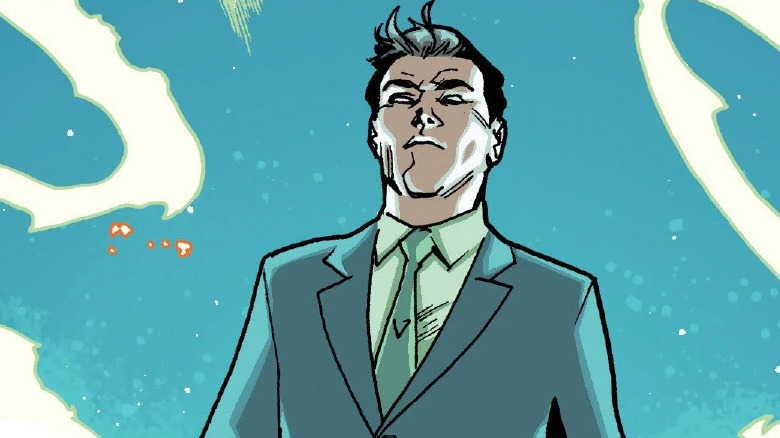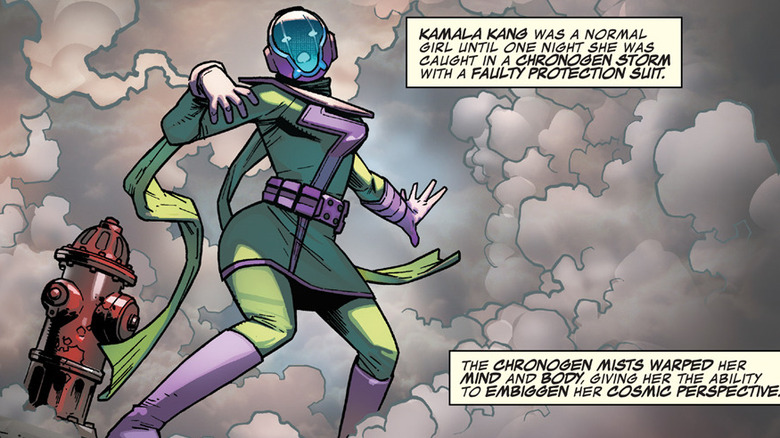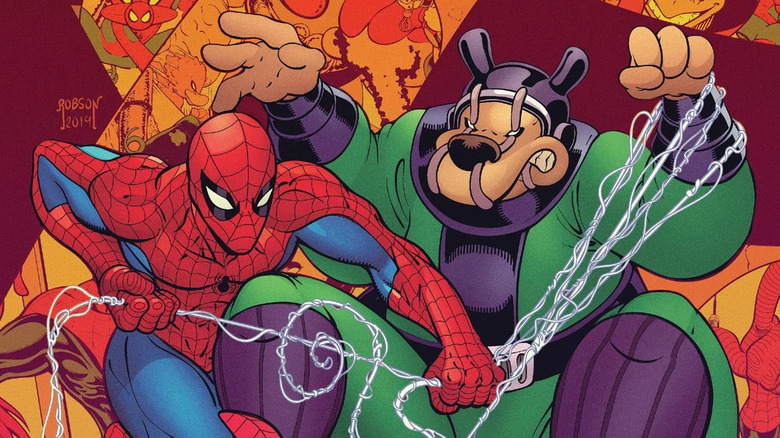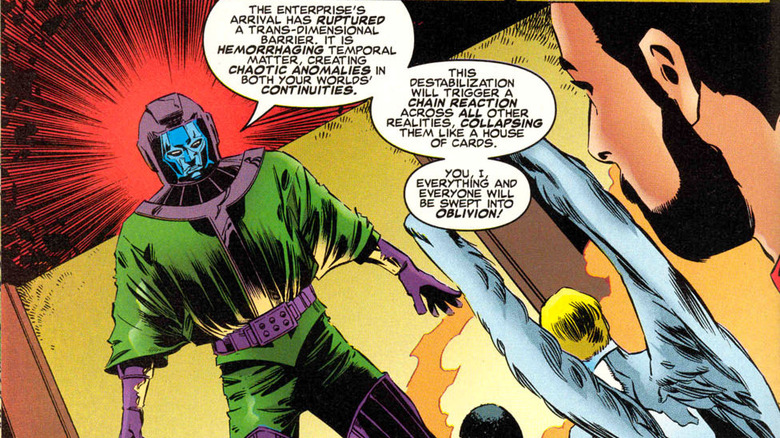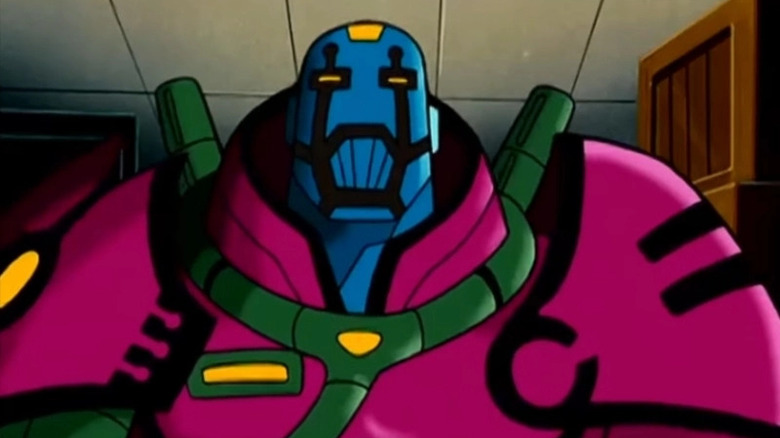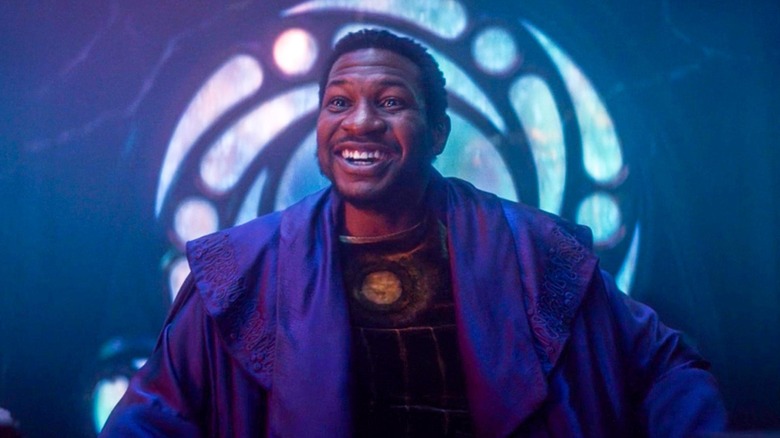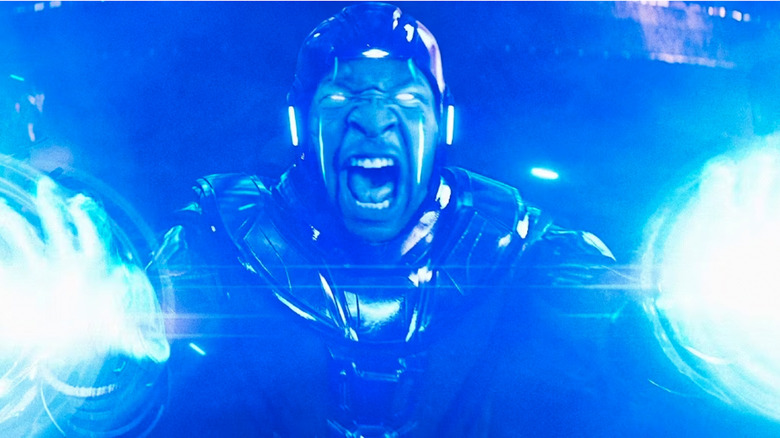How Many Variants Of Kang Exist In Marvel's History?
Kang the Conqueror may be one of the most interesting comic book characters ever conceived. Because of his fixation with time travel, the Marvel staple has seen numerous additions to his biography since an initial introduction in 1963's "Fantastic Four" #19, altering his past, present, and future.
In fact, in his first appearances, readers wouldn't even learn that he was Kang at all. But when he re-emerged in the pages of "Avengers" he had a new look, a new name, and he revealed to the heroes his complicated past and origins across time. Complicated doesn't begin to describe Kang the Conqueror's adventures, because with his ceaseless time traveling and divergent timelines, there are an infinite number of Kangs out there. Many of them pop up from time to time and it can be hard to untangle which is which, and if they are even from the same reality. As a result, Kang has a staggering amount of variants, spanning across comics, movies, and TV shows.
Though Jonathan Majors was revealed as "He Who Remains" in the Disney+ series Loki, MCU fans are finally going to see Kang the Conqueror in his true form in "Ant-Man and the Wasp: Quantumania." In honor of this official introduction to the Marvel Cinematic Universe, here's a look at some of his variants throughout Marvel history, from the 1960s to today.
Rama-Tut
Rama-Tut was the first version of Kang to be introduced into the Marvel Comics Universe, though readers wouldn't know it at the time. He shows up first in a "Fantastic Four" issue as a criminal from the future who travels back in time to conquer ancient Egypt. In that first appearance, he is depicted as having grown bored of the peaceful world of the future, and so traveled back to become ruler of Egypt in the past. Looking for excitement, he lures the Fantastic Four back in time just for a bit of fun, but is eventually defeated, after which he leaves for his own time in the far-flung future.
Later tales of Rama-Tut's time in Egypt reveal much more, including encounters with the ancient mutant En Sabah Sur — also known as Apocalypse — as well as the Egyptian God Konshu, benefactor of the hero Moon Knight. During his years as Rama-Tut he also came into conflict with the likes of the West Coast Avengers, Dr. Strange, and even Dr. Doom. But after leaving the region for good, Rama-Tut decided to take on a new persona, one with more colorful, futuristic armor, an idea sparked from a meeting with the Latverian dictator.
Kang went back and forth on this guise, returning to the form of Rama-Tut on more than one occasion. But like anything related to Kang, his time travel has led to numerous retcons, and things can get increasingly confusing the more you learn about him.
Scarlet Centurion
After abandoning his Rama-Tut persona, Nathaniel Richards adopted the moniker of the Scarlet Centurion. He first appears in "Avengers" Annual #2 in 1968, though when he first shows up, the Avengers have no idea who he is despite his familiarity with them. In this story, he offers the Avengers the opportunity to turn Earth into a utopia. In a bizarre plan, the Scarlet Centurions helps the Avengers capture every major superhero and defeat every villain in the world, because according to him it's their very existence that is preventing the planet from becoming a paradise. In doing so, the Avengers inadvertently become dictators themselves.
In another adventure, The Scarlet Centurion forces two different eras of Avengers teams to battle one another, and in a later storyline fight the Squadron Supreme. While he'd take the name Kang the Conqueror shortly thereafter, this wouldn't be the only version of the Scarlet Centurion: Like Kang, even he has variants from many divergent timelines.
But there's also a second, entirely different Scarlet Centurion who is actually Marcus Kang of Earth-6311, the son of Kang the Conqueror. The two once teamed up in the storyline titled "Kang Dynasty" (from which the next "Avengers" film takes its name) that saw them attempt to take over the Earth in an effort to save it from destruction.
Marvel Comics Prime Kang the Conqueror
Although Rama-Tut was Kang's original beginning, he's received many rewrites and retcons.
The comic book Kang the Conqueror that we know is Nathaniel Richards, a descendant of Mr. Fantastic Reed Richards' time-traveling father. Nathaniel lives in the 31st century and, in "Fantastic Four" #273, decides to use the time-traveling technology created by Dr. Doom to go back in time and conquer Egypt, becoming the Pharaoh Rama-Tut, another version of Kang. After being defeated by the Fantastic Four, Nathaniel meets Doom in the 20th century, who inspires him to create his iconic suit of armor. Nathaniel then attempts to go home to his time but overshoots it and ends up in the 40th century, where he easily conquers the now war-torn Earth. He dubs himself Kang the Conqueror and leaves his dying world to rule earlier versions of the planet.
This version of Kang the Conqueror is the iconic one that comic book fans know and love. He's most known as a recurring villain for both The Avengers and The Fantastic Four. Each time he fought either group, he created alternate versions of himself. This culminated in the Prime Kang creating the Council of Cross-Time Kangs, a group of, you guessed it, multiversal Kangs who ruled over the multiverse before the Prime Kang destroyed them.
Victor Timely
Another variant of Kang once traveled back to the beginning of the 20th century and took on the name Victor Timely (a nod to Marvel's own origins, as during the 1940s they were known as Timely Comics). Arriving at the turn of the century, this Kang established himself as a prominent mid-Western American. He founded the town of Timely, Wisconsin, served as its mayor, and eventually founded Timely Industries, which encompassed a number of factories and smaller subsidiaries.
Timely also served as a kind of genius inventor, patenting his future technology to help advance his agenda in this time period. From time to time, he also used robot duplicates of his Victor Timely persona to allow him to adventure as Kang proper with nobody being the wiser. As Timely, this version of Kang lived well into the 1980s, eventually posing as the grandson of the "original" Victor Timely; by this time, his company was one of the world's leading technology firms.
In fact, Timely tech was used by his foes the Fantastic Four, the cyborg hero Deathlok, and more. He was also responsible for introducing Phineas Horton to the technology that would lead to the android Human Torch, which ultimately led to the creation of the Vision.
Though his appearances were few, unconfirmed rumors that Victor Timely could show up in "Ant-Man and the Wasp: Quantumania" suggest that this is one Kang persona to keep an eye on.
Kang joined the Young Avengers as Iron Lad
Earth-6311, an alternate universe that never went through the Dark Ages, is brought to peace by Nathaniel Richards, the Prime Kang. Later, another Nathaniel Richards is born on Earth-6311, said to be a descendant of the Prime Kang, but that lineage gets a little confusing.
First appearing in "Young Avengers" #1, Nathaniel Richards is a genius kid who gets rescued from a bully by Kang the Conqueror, his future self. Kang gifts Nathaniel a suit of armor and shows him his future, destined to fight against the Avengers. Nathaniel wants no part of that future and uses his new time-traveling suit to go to Earth-616. He finds Avengers Mansion destroyed, and in his search for Tony Stark, he finds Vision's remains. He downloads Vision's memories and finds files on potential Avengers recruits: Eli Bradley, Teddy Altman, and Billy Kaplan. Nathaniel finds each of them and creates the Young Avengers with Bradley as Patriot, Altman as Hulkling, Kaplan as Asgardian, and himself as Iron Lad.
While Iron Lad eventually returned to his original time, Nathaniel began traversing the multiverse, attempting to stop all versions of Kang the Conqueror. He went on to feature in the large comic book storylines "Children's Crusade" and "Original Sin."
Iron Lad and the Young Avengers quickly became fan favorites, so fans hope that the MCU gets their version of this team, potentially featuring a younger Nathaniel Richards.
Immortus is the Kang that watches over the other Kangs
The Kang timeline gets even more complicated with Immortus. An older version of Kang grew tired of ruling his empire, which had grown so large that he didn't participate in any battles. Instead, in "Avengers Forever" #9, Nathaniel decides to return to a simpler life in Egypt as the Pharaoh Rama-Tut, leaving his empire to his lover. Eventually, Rama-Tut returns to the present day to help the Avengers stop Kang, introducing himself to his younger self as Immortus. Although both Kang and Immortus were different versions of the same character, after the events of "Destiny War," the two are split.
Immortus then began studying Limbo and joined the Time-Keepers to further explore the alternate dimension and time itself. They tasked him with watching over past versions of himself and altering the course of history so that the Time-Keepers remained at the end of time. This version of Kang the Conqueror served as the inspiration behind He Who Remains in "Loki."
Immortus has the richest history among all the Kang variants. He featured in many different comic arcs, serving as an enemy to the Avengers in some and an ally in others. He manipulated Iron Man resulting in "The Crossing" storyline, served as the primary antagonist during "Destiny War," and turned ally in "Uncanny Avengers" #5, which led to the "Avenge the Earth" storyline.
Kid Immortus is here for a short, but fun time
To make the timeline just a bit more confusing, there's another version of Kang that's a mix of Iron Lad and Immortus, known as Kid Immortus. First appearing in "FF" Vol. 2 #8, Kid Immortus came to be after Nathaniel Richard/Iron Lad left Earth-616 to return to his world. Tired of fighting against his destiny to become a villain, Nathaniel decides to get a jump on his future and turn evil earlier. He studies his own destiny and adopts the moniker Kid Immortus. He's informed of another Kang that fused with Dr. Doom and Annihilus to become Doom the Annihilating Conqueror and traveled back in time to convince Doom to do this earlier.
In an attempt to defeat the Fantastic Four earlier, Kid Immortus travels back in time, but Doom rejects his many attempts to merge. Kid Immortus, Doom, and Annihilus worked together to plan the Fantastic Four's downfall, but the Future Foundation (FF) thwarted their plans. When the FF attacked the villains, Doom again refused to fuse with Kid Immortus and Annihilus, deeming them inferior. Instead, he turned on both of them and fought them and the FF. Kid Immortus was knocked out but rescued and returned to his original time. He would later accept his destiny, becoming Rama-Tut, Kang the Conqueror, and Immortus.
Kang the Conglomerate
Not every Kang variant uses the nickname "The Conqueror"; one more recent addition to the pantheon of Kangs from Earth-34295 departs from this convention. Like Timely before him, he too is a businessman, but his aims are quite different.
While he's not technically from the Marvel 2099 universe (which would be Earth-928), Kang the Conglomerator is from the year 2099, and a reality that somewhat resembles the one depicted in the likes of "Spider-Man 2099," first published in the early 1990s. Unlike most versions of the character, Kang the Conglomerator seemingly has no desire to conquer much of anything beyond the business world; his predominant interest is simple profit, earned through his licensing and marketing corporation.
Debuting in the pages of "Edge of Spider-Geddon" #1, this variant of Kang owns a company called Kangco Inc. Ltd, and makes his fortune by merchandising the superheroes of his era. But he does have time travel powers, and comes to "present" day in order to bring Spider-Punk (yes that's a character, though he isn't always fond of the name "Spider-Punk") into his own time, to make even more profit off his entertainment rights. Eventually, with the help of the Hulk and a little punk rock, Kang the Conglomerator ultimately fails in his plan to bring Spider-Punk into the future. Admittedly, weirdness was kind of the point of the series.
Mr. Gryphon
While Kang the Conglomerator was a satirical, tongue-in-cheek character spoofing corporate greed in the media and entertainment industry, Mr. Gryphon is something far more serious. In the pages of "All-New, All-Different Avengers" #1 in 2015, readers were introduced to a shrewd business mogul named Mr. Gryphon, CEO of Qeng Enterprises, a multinational corporation that purchased Stark Tower from Iron Man and the Avengers. As it turns out though, Mr. Gryphon was a false identity for a new version of Kang the Conqueror, who had split into two separate versions of himself following a mishap in time.
Trapped in the modern era, this new version of Kang set himself up with the identity of Mr. Gryphon and attempted to use a newly-formed business to bring about a Kang Dynasty in the 21st century. His plan involved transporting a massive army of Chitauri warriors to Earth. Thankfully, the Avengers were able to reform, with a roster that included Iron Man, Spider-Man, Ms. Marvel, Vision, Jane Foster's Thor, and Sam Wilson's Captain America. Together, they were able to expose Gryphon and stop his plot to conquer Earth.
Kamala Kang
One of the stranger versions of Kang debuted in Marvel's "Infinity Wars" mini-series in 2018. In that title, Gamora (of the Guardians of the Galaxy) assembles the Infinity Stones and uses them to bring every soul in the cosmos within the confines of the Soul World that resides in the Soul Stone. But one unforeseen side effect of her scheme was to reshape all of reality with a new history, eventually creating what became known as Warp World. Much like the 1990s Marvel/DC crossover event "Amalgam," the story sees a number of new characters who come into being as two existing heroes or villains, blended together.
In addition to the likes of Soldier Supreme (a mix of Captain America and Dr. Strange) and Iron Hammer (Tony Stark and Thor), one new character that emerged from this story was Kamala Kang, a combination of Kamala Khan — Ms. Marvel — and Kang the Conqueror. In Warp World, Kamala Kang is a time traveling hero who is exposed to the Chronogen Mist, which increases her cosmic awareness and activates her Inhuman genes, giving her embiggening powers. Though she only existed for a short time in the comics, she managed to have brief run-ins with Emma Frost, Rawhide Kid, and Loki — who eventually helped separate her back into Ms. Marvel and Kang.
Kangaroo the Conqueror
If you thought Kang the Conglomerator and Kamala Kang were strange, wait until you get a load of this one: Kangaroo the Conqueror. Unlike those other weird Kang variants though, this one actually hails from a fan-favorite fictional universe. While it's designation is Earth-8311, "Spider-Man" fans will know is as the universe from which Peter Porker, the Spectacular Spider-Ham hails, and which made its first appearance in 1983. In this world, all of the heroes and villains of the Marvel universe are re-imagined as animal cartoon characters. This includes Goose Rider, Captain Americat, and Norman Osbird, the Green Gobbler (he's a turkey).
Kangaroo the Conqueror first showed up in issue #15 of "Peter Porker, the Spectacular Spider-Man" in 1987. While he didn't have much to do in that issue, he does reappear a few more times, and gets a bit of the spotlight in a 2020 miniseries "Spider-Ham," where he appears alongside several other versions of Kang, including the Council of Kangs. In that story, Kangaroo the Conqueror allies himself with the real Spider-Man and Spider-Ham, in an effort to stop an alternate version of Kang from destroying the animal Earth. He winds up gifting the two Spider-men versions of his own costume and dubs the trio the Kang Club.
Kang of the final frontier
In 1998, Marvel Comics published a crossover between the X-Men and the crew of the starship Enterprise from "Star Trek: The Next Generation" titled "Second Contact." When it was announced that the two groups would join forces to take on Kang, some diehard "Trek" fans may have suspected the villain would be the Klingon warrior played by Michael Ansara in the classic episode "Day of the Dove." Instead, it was Marvel's master of time, Kang the Conqueror, and while he appears identical to his Marvel 616 counterpart, it's suggested that he may actually be an entirely different version of the character.
In the story, Captain Picard and his crew are hurtled back in time and into an alternate reality, where they meet Professor X and the X-Men. They also encounter the time-traveling villain Kang, and are tricked into repairing a pair of spatial anomalies that he claimed were breaking down the barriers between realities. In the end, Wesley Crusher and The Traveler are able to see through his scheme and help stop him.
While it was a decent romp, the real shame is that readers never got a mashed-up version of both universe's Kangs, as it would have been much more fun to see Kang the Conqueror as a Klingon.
Kang of the animated 41st century
Kang the Conqueror has appeared in a number of animated Marvel projects over the years. Most of them have been fairly faithful translations, as he popped up in the original Fantastic Four cartoon in 1967 as Rama-Tut, and in "Avengers Assemble," "Avengers: Earth's Mightiest Heroes," and even the anime "Marvel's Future Avengers." But one animated version of Kang is noteworthy for just how different he is from his comic book counterpart. Admittedly, that's par for the course when it comes to the mostly-forgotten 1999 cartoon "Avengers: United They Stand."
In this oddball animated series, plenty of liberties are taken with just about everyone, and Kang is no different. Here, he emerges from an ancient Egyptian relic and continues his ongoing quest to conquer all of time, and oddly enough it's Ant-Man who he greets first. He claims to hail from the 41st century, where he ruled over Earth as a tyrannic despot, and threatens to do the same in the present day. For some reason though, this Kang bears almost no resemblance to his comic book counterpart instead resembling more of a hulking robot of some sort.
Thankfully, these goofy-looking Avengers — who in addition to Ant-Man consist of the Wasp, Falcon, Tigra, Hawkeye, Vision, Wonder Man, and the Scarlet Witch — are there to stop him from getting his hands on the obelisk he needs to regain his full powers.
He Who Remains
After the heroes of the MCU joined forces and defeated Thanos in "Avengers: Endgame," many fans wondered who the next big bad would be. They seemingly got their answer at the conclusion of the first season of the Disney+ series "Loki," when a sinister figure known as "He Who Remains" was living at the end of time, and watching over the entire Marvel Multiverse.
A Kang variant played by Jonathan Majors in his first appearance in the MCU, He Who Remains explained that there had once been a war between parallel worlds. After coming out on top, he eliminated countless divergent alternate realities, and created the Time Variance Authority to ensure the safety and purity of what he called The Sacred Timeline. Though some have viewed him as a megalomaniacal villain, He Who Remains explained that he was fighting to prevent a war that could annihilate all of existence. He also warned that if he were killed, there would be no stopping the expansion of alternate timelines, and with it, the emergence of an even more terrifying version of himself.
While he offered Loki the chance to take his place and watch over the Sacred Timeline, Sylvie — whose existence was a divergence — took it upon herself to kill He Who Remains, unleashing the multiverse. Despite only having a small role in "Loki," he may turn out to be one of the most important characters in the Multiverse Saga, whose death set it all in motion.
Kang of the MCU
In "Ant-Man and the Wasp: Quantumania," fans will finally get their best look at the MCU's Kang the Conqueror, played by Jonathan Majors. This is a new variant of the "He Who Remains" we met in "Loki," and he seems set to be a far greater threat to the Marvel Multiverse than the man who wanted to safeguard the Sacred Timeline.
This new version will finally take the proper moniker of Kang the Conqueror, and he resides — or rather, seems trapped — in the Quantum Realm, where Ant-Man, the Wasp, daughter Cassie, and Hank and Janet find him. Wearing his iconic suit of armor and now with a piece of headgear that provides him with his signature blue face, he's a near literal translation of his original comic book counterpart, energy-blasting powers and all. Despite being in the Quantum Realm, he has knowledge of events outside it, and even of multiple timelines. He also has a mastery of time just as in the comics, with the ability to reshape existence and destroy timelines, although his ultimate goals remain unknown.
Although little is known about the MCU's Kang, it is clear that each Kang has memories of other versions of himself. It'll be interesting to see what Marvel Studios does with the character — and since there are countless more of him, it seems likely that the one in "Avengers: The Kang Dynasty" in 2025 could be yet another new variant.
